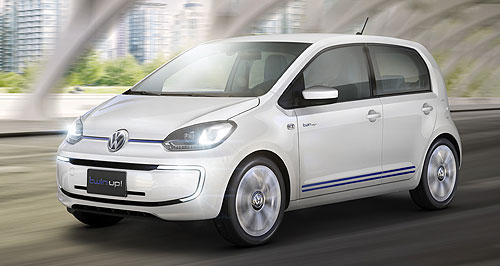Make / Model Search
News - Volkswagen - Up! - Twin Up!A look at Volkswagen's futureFuture-proof: The Volkswagen Twin Up (below) shares the XL1's diesel-electric powertrain. Expect this sort of technology to flourish, with VW recently committing a vast sum to green-car development. Volkswagen premieres diesel-electric Up, makes massive R&D commitment to 2018Gallery Click to see larger images 27 Nov 2013 EUROPE’S largest vehicle-maker Volkswagen will plough 84 billion euros ($A125b) into its Automotive Division between 2014 and 2018, two-thirds of which will go to direct or indirect development of greener vehicles, and much of which will be spent in Germany. The news comes around the same time as the company premieres the latest concept version of its Up city car, this time using the ultra frugal diesel-electric plug-in hybrid system pioneered in the radical XL1 coupe. This means a combination of a 35kW 800cc TDI engine and a 35kW motor, a seven-speed DSG dual-clutch transmission and a 8.6kWh lithium-ion battery pack. The driver determines when to drive in all-electric mode by the press of a button. VW quotes a pure EV range of 50km, a 140km/h top speed and a combined fuel consumption figure beyond fully electric operation of just 1.1 litres per 100km. The 33-litre fuel tank promises a huge maximum range. No doubt cars such as this, and the $125b commitment to fund them (among many other things), will go some way to powering Volkswagen to a position as a global leader in vehicle electrification, a feat that chairman of the board of management Dr Martin Winterkorn canvassed as a key goal at a keynote speech in Frankfurt to media last September. Investments in property, plants and equipment within the greater Automotive Division will amount to $A94b of the total. Despite being a seemingly vast sum, this is around A$750 million less than in the planning approved in 2012 for the period from 2013 to 2015. “In times like these, our disciplined cost and investment management will remain a cornerstone of our activities”, said Dr Winterkorn this week. Investments in products and technologies remain unaffected by the decline, according to a company release. According to the company, about 65 per cent of the $94b allocated to property, plants and equipment will be towards modernising and extending the already vast produce range across all brands: Volkswagen, Audi, Porsche, Skoda, Seat, Lamborghini, Bugatti and Ducatti. The main focus, it says, will be on new vehicles and successor models in almost all vehicle classes, which will be based on the ‘modular toolkit technology (such as the small- and medium-car MQB architecture) and related components. “This will allow the Volkswagen Group to systematically continue its model rollout with a view to tapping new markets and segments,” the company says. In addition, new generations of engines will be launched offering “additional enhancements to performance, fuel consumption and emission levels”. In particular, the Group says it will continue to press ahead with the development of hybrid and electric motors.Interestingly, about 60 per cent of the investments in property, plant and equipment will be made in Germany, which seems to represent a contradiction to some makers that are increasingly looking towards developing or emerging markets beyond a stagnant Europe. “The amount being invested in Germany is a strong testament to the fact that our home locations will continue to play a key role in the globally positioned Group going forward”, said Dr Winterkorn. “At Volkswagen, we are clearly committed to Germany as a manufacturing and development location.” Nevertheless, a sum of about $A27b will be invested over this time by Volkswagen’s Chinese joint-ventures, however these figures (financed from the JVs’ own funds) are not consolidated and therefore counted as separate to the $125b figure. The $A125b also include “capitalised development costs” of $A29b - mostly down to due to upfront investments in connection with the Group's CO2 emissions targets - and other investments including for financial assets in the amount of $A1.9b.  Read more |
Click to shareVolkswagen articlesResearch Volkswagen Motor industry news |






















Facebook Twitter Instagram